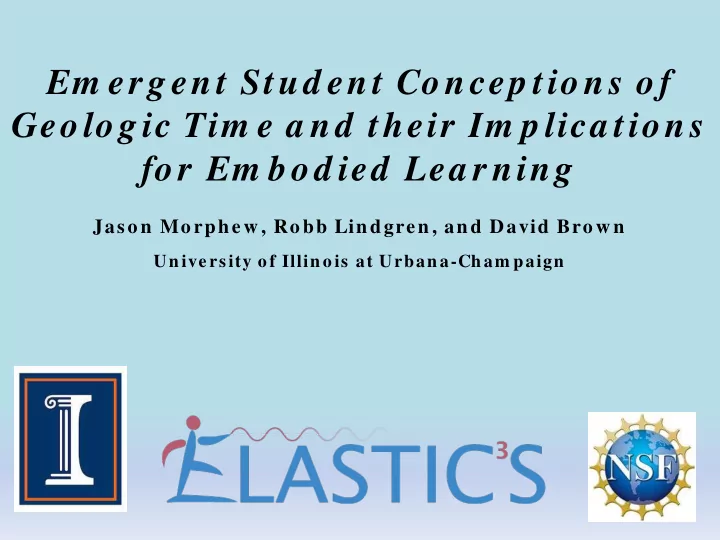

Em ergent Stud ent Concep tions of Geolog ic Tim e a nd their Im p lica tions for Em bod ied Lea rning Jaso n Mo rphew , Ro bb Lindgren, and David Bro w n Un iversity o f Illin o is at Urban a-Cham paign
E mbodied L earning A ugmented through S imulation T heaters for I nteracting with C ross- C utting C oncepts in S cience
• Individuals are able to place geologic events in correct relative order, however are less able t0 place events in absolute order (Catley & Novick, 2009; Cheek, 2012). • Timelines exhibit temporal compression (Libarkin et al., 2007)
• Students’ difficulties in understanding geologic time may be due to several factors, which most likely work in concert (Cheek, 2010). – Use of events to measure time (Resnick, Atit, and Shipley, 2012). – Lack of content knowledge (Delgado, 2013; Libarkin et al., 2005). – Inability to conceptualize large numbers or engage in proportional reasoning (Cheek, 2012; Hidalgo and Otero, 2004).
This study addresses two questions. • 1) How do students understand and make sense of large numbers when reasoning about time? • 2) How do students draw upon this informal reasoning when asked to create a formal geologic timeline?
Interview Tasks and Procedure • Students enrolled in Educational Psychology (N = 13) completed task-based interviews. • Students were first asked to think about how they understood or made sense of different units of time. • They were then asked to explain their answers using gestures to highlight the differences between several time intervals. • Finally, the participants were explicitly asked to create a geologic timeline. Event Approx. Time Invention of the phone 100 years First Europeans to sail to America 1,000 years First use of fire 1,000,000 years Extinction of Dinosaurs 65,000,000 years Dinosaurs Appeared 230,000,000 years First Life Appeared 3,000,000,000 years Formation of the Earth 5,000,000,000 years
Framework for analysis • Student conceptions viewed as dynamically emergent structures which can be viewed through three different lenses (Brown, 1992; 2014).
Visual Differences as a Conscious Model for Time “One hundred years would be more recent in terms of today. Like society would have been different but it wouldn’t have been as different, like, as drastic a change from one thousand years ago.” ~ Samantha
Elizabeth “Based on what scientists have found, and “I can’t imagine what that was like. It was so stuff like that, you could show them pictures of different from where we are now.” what supposedly what Earth used to be like. And like the way it’s changed and stuff like that. And that might help them see how much, or how long ago it was and how much has changed”
Context Affects the Conscious Model
Deanna 5 billion 3 billion 230 million
Implicit models • Conceptions of time draw upon our spatial understandings and experiences (Lakoff & Johnson, 1999).
Time Metaphors - “We are getting close to the deadline.” - “The time for action has passed.” - “We got through the busy part of the - “The concert will be here soon.” semester.” Images adapted from Gentner, Imai, and Boroditsky (2002) Moving Attention Perspective Image from Casasanto, and Jasmin (2012)
5 billion 3 billion 1000 230 million 100
Amanda 100 1000 1 million
Size of time interval depends on when it occurred
Deanna Amanda
Educational Implications
First Attempt After Gesturing
Educational Implications • Educational interventions which include embodied or experiential components are beneficial (Hester, 2008) . – Use rich description of the environment, biota, and geology of the different geologic times. – Emphasize the hierarchical relationships between geological events (Resnick, et. al., 2012) – Embodied immersive mixed reality simulations show promise.
Questions? jmorphe2@illinois.edu http:/ / elastics.education.illinois.edu
Recommend
More recommend